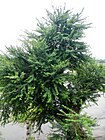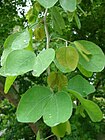Note: This is a project under development. The articles on this wiki are just being initiated and broadly incomplete. You can Help creating new pages.
Difference between revisions of "Pithecellobium dulce"
(→References) |
|||
| (10 intermediate revisions by the same user not shown) | |||
| Line 1: | Line 1: | ||
| − | + | [[File:Starr 031209-0011 Pithecellobium dulce.jpg|thumb|right]] | |
| + | '''Pithecellobium dulce''' is a fast-growing tree with a generally broad and spreading or rounded crown. It usually grows from 10 - 15 metres tall. It ranges between 5 and 18 metres. Multiple boles are often formed, These are usually short, Generally 30 - 50cm in diameter but up to 100cm. The tree is widely cultivated as an ornamental, Shade-providing plant in the tropics. It is also grown in South America for its fruit and seed. | ||
==Uses== | ==Uses== | ||
| − | {{Uses|}}, {{Uses|}}, {{Uses|}}, {{Uses|}}, {{Uses|}}, {{Uses|}}, {{Uses| | + | {{Uses|Swellings}}, {{Uses|Venereal sores}}, {{Uses|Indigestion}}, {{Uses|Diarrhea}}, {{Uses|Dysentery}}, {{Uses|Haemoptysis}}, {{Uses|Internal ulcers}}.<ref name="Uses"/> |
==Parts Used== | ==Parts Used== | ||
| − | {{Parts Used|}}, {{Parts Used| | + | {{Parts Used|Bark}}, {{Parts Used|Fruits}}<ref name="Karnataka Medicinal Plants"/> |
==Chemical Composition== | ==Chemical Composition== | ||
| − | <ref name="chemical composition"/> | + | It contains the powders were analyzed for moisture, total ash, crude fat, crude protein, reducing sugars, total sugars, crude fiber, anthocyanin contents and acidity by using standard methods<ref name="chemical composition"/> |
==Common names== | ==Common names== | ||
| − | {{Common names | + | {{Common names|en=Manilla Tamarind|hi=Dakhani Babool|kn=Sime Hunase Mara, Manilla Hunase|ml=Kodappuli|ta=Karkapilli|te=Simachinta}}<ref name="Karnataka Medicinal Plants"/> |
==Properties== | ==Properties== | ||
| Line 16: | Line 17: | ||
===Dravya=== | ===Dravya=== | ||
===Rasa=== | ===Rasa=== | ||
| − | |||
===Guna=== | ===Guna=== | ||
| Line 29: | Line 29: | ||
==Habit== | ==Habit== | ||
| − | {{Habit|}} | + | {{Habit|Tree}} |
==Identification== | ==Identification== | ||
| Line 36: | Line 36: | ||
===Flower=== | ===Flower=== | ||
| − | {{Flower||||}} | + | {{Flower|||||Flowering season is February - May}} |
===Fruit=== | ===Fruit=== | ||
| − | {{Fruit||||||}} | + | {{Fruit||||||Fruiting season is February - May}} |
===Other features=== | ===Other features=== | ||
| Line 51: | Line 51: | ||
==How to plant/cultivate== | ==How to plant/cultivate== | ||
| − | <ref name="How to plant/cultivate"/> | + | The tree grows well at low and medium altitudes in both wet and dry areas of the tropics.<ref name="How to plant/cultivate"/> |
==Commonly seen growing in areas== | ==Commonly seen growing in areas== | ||
| − | {{Commonly seen|}}, {{Commonly seen|}}, {{Commonly seen| | + | {{Commonly seen|Thinly forested plains}}, {{Commonly seen|Hillsides}}, {{Commonly seen|Coastal thickets}}. |
==Photo Gallery== | ==Photo Gallery== | ||
<gallery class="left" caption="" widths="140px" heights="140px"> | <gallery class="left" caption="" widths="140px" heights="140px"> | ||
| − | + | FvfCamachile8608.JPG | |
| + | Gardenology.org-IMG 7761 qsbg11mar.jpg | ||
| + | Gardenology.org-IMG 7762 qsbg11mar.jpg | ||
| + | Starr 070111-3119 Pithecellobium dulce.jpg | ||
| + | Starr 080607-7308 Pithecellobium dulce.jpg | ||
| + | Starr 080607-7309 Pithecellobium dulce.jpg | ||
| + | Starr 080607-7311 Pithecellobium dulce.jpg | ||
</gallery> | </gallery> | ||
| Line 64: | Line 70: | ||
<references> | <references> | ||
| − | <ref name="chemical composition">[ | + | <ref name="chemical composition">[https://www.ncbi.nlm.nih.gov/pmc/articles/PMC3551085/ Chemical constituents]</ref> |
| − | <ref name="Leaf">[" | + | <ref name="Leaf">[Morphology]</ref> |
| + | <ref name="Karnataka Medicinal Plants">"Karnataka Medicinal Plants Volume - 2" by Dr.M. R. Gurudeva, Page No.710, Published by Divyachandra Prakashana, #45, Paapannana Tota, 1st Main road, Basaveshwara Nagara, Bengaluru. </ref> | ||
| − | <ref name="How to plant/cultivate">[ | + | <ref name="How to plant/cultivate">[http://tropical.theferns.info/viewtropical.php?id=Pithecellobium+dulce Cultivation]</ref> |
<ref name="Uses">Indian Medicinal Plants by C.P.Khare</ref> | <ref name="Uses">Indian Medicinal Plants by C.P.Khare</ref> | ||
</references> | </references> | ||
==External Links== | ==External Links== | ||
| − | * [ ] | + | * [https://www.feedipedia.org/node/263 Pithecellobium dulce on feedipedia.org] |
| − | * [ ] | + | * [https://indiabiodiversity.org/species/show/266702 Pithecellobium dulce on indiabiodiversity.org] |
| − | * [ ] | + | * [http://www.flowersofindia.net/catalog/slides/Madras%20Thorn.html Pithecellobium dulce on flowersofindia.net] |
[[Category:Herbs]] | [[Category:Herbs]] | ||
[[Category:Pages without herbs images]] | [[Category:Pages without herbs images]] | ||
Latest revision as of 12:53, 18 July 2023
Pithecellobium dulce is a fast-growing tree with a generally broad and spreading or rounded crown. It usually grows from 10 - 15 metres tall. It ranges between 5 and 18 metres. Multiple boles are often formed, These are usually short, Generally 30 - 50cm in diameter but up to 100cm. The tree is widely cultivated as an ornamental, Shade-providing plant in the tropics. It is also grown in South America for its fruit and seed.
Contents
- 1 Uses
- 2 Parts Used
- 3 Chemical Composition
- 4 Common names
- 5 Properties
- 6 Habit
- 7 Identification
- 8 List of Ayurvedic medicine in which the herb is used
- 9 Where to get the saplings
- 10 Mode of Propagation
- 11 How to plant/cultivate
- 12 Commonly seen growing in areas
- 13 Photo Gallery
- 14 References
- 15 External Links
Uses
Swellings, Venereal sores, Indigestion, Diarrhea, Dysentery, Haemoptysis, Internal ulcers.[1]
Parts Used
Chemical Composition
It contains the powders were analyzed for moisture, total ash, crude fat, crude protein, reducing sugars, total sugars, crude fiber, anthocyanin contents and acidity by using standard methods[3]
Common names
| Language | Common name |
|---|---|
| Kannada | Sime Hunase Mara, Manilla Hunase |
| Hindi | Dakhani Babool |
| Malayalam | Kodappuli |
| Tamil | Karkapilli |
| Telugu | Simachinta |
| Marathi | NA |
| Gujarathi | NA |
| Punjabi | NA |
| Kashmiri | NA |
| Sanskrit | NA |
| English | Manilla Tamarind |
Properties
Reference: Dravya - Substance, Rasa - Taste, Guna - Qualities, Veerya - Potency, Vipaka - Post-digesion effect, Karma - Pharmacological activity, Prabhava - Therepeutics.
Dravya
Rasa
Guna
Veerya
Vipaka
Karma
Prabhava
Habit
Identification
Leaf
| Kind | Shape | Feature |
|---|---|---|
Flower
| Type | Size | Color and composition | Stamen | More information |
|---|---|---|---|---|
| Flowering season is February - May |
Fruit
| Type | Size | Mass | Appearance | Seeds | More information |
|---|---|---|---|---|---|
| Fruiting season is February - May |
Other features
List of Ayurvedic medicine in which the herb is used
Where to get the saplings
Mode of Propagation
[[:Category:Index of Plants which can be propagated by |]]
How to plant/cultivate
The tree grows well at low and medium altitudes in both wet and dry areas of the tropics.[5]
Commonly seen growing in areas
Thinly forested plains, Hillsides, Coastal thickets.
Photo Gallery
References
- ↑ Indian Medicinal Plants by C.P.Khare
- ↑ 2.0 2.1 "Karnataka Medicinal Plants Volume - 2" by Dr.M. R. Gurudeva, Page No.710, Published by Divyachandra Prakashana, #45, Paapannana Tota, 1st Main road, Basaveshwara Nagara, Bengaluru.
- ↑ Chemical constituents
- ↑ [Morphology]
- ↑ Cultivation
External Links
- Ayurvedic Herbs known to be helpful to treat Swellings
- Ayurvedic Herbs known to be helpful to treat Venereal sores
- Ayurvedic Herbs known to be helpful to treat Indigestion
- Ayurvedic Herbs known to be helpful to treat Diarrhea
- Ayurvedic Herbs known to be helpful to treat Dysentery
- Ayurvedic Herbs known to be helpful to treat Haemoptysis
- Ayurvedic Herbs known to be helpful to treat Internal ulcers
- Herbs with Bark used in medicine
- Herbs with Fruits used in medicine
- Herbs with common name in Kannada
- Herbs with common name in Hindi
- Herbs with common name in Malayalam
- Herbs with common name in Tamil
- Herbs with common name in Telugu
- Herbs with common name in English
- Habit - Tree
- Index of Plants which can be propagated by
- Herbs that are commonly seen in the region of Thinly forested plains
- Herbs that are commonly seen in the region of Hillsides
- Herbs that are commonly seen in the region of Coastal thickets
- Herbs
- Pages without herbs images







